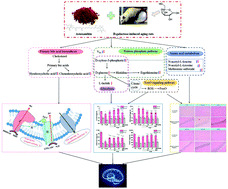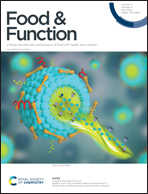Astaxanthin attenuates d-galactose-induced brain aging in rats by ameliorating oxidative stress, mitochondrial dysfunction, and regulating metabolic markers†
Abstract
Astaxanthin (AX) is a red-colored xanthophyll carotenoid with potent antioxidant, anti-inflammatory, and neuroprotective properties. However, the underlying in vivo mechanism by which AX protects the brain from oxidative stress remains unclear. In this study, we investigated the protective effect of AX on brain oxidative damage in a D-galactose-induced rat model of aging. We also explored its possible mechanism of action by analyzing the resulting serum metabolic profiles. Our results showed that AX significantly increased the activities of catalase (CAT), superoxide dismutase (SOD), and glutathione peroxidase (GSH-Px) by 26%, 30%, and 53%, respectively. AX also significantly increased the mitochondrial membrane potential by 18% when compared with the model group. Additionally, treatment with AX (15 mg kg−1) increased the activities of respiratory chain complexes I and IV by 50.17% and 122.87%, respectively. Furthermore, AX also improved age-related morphological changes in the cerebral cortex and hippocampus. Significant differences in serum metabolic profiles were observed between the D-galactose and AX treatment groups. AX corrected amino acid metabolic problems by increasing the levels of N-acetyl-L-leucine, N-acetyl-L-tyrosine, and methionine sulfoxide to protect nerve cells. This also allowed AX to regulate the pentose phosphate pathway by acting on ergotoxine, D-xylose-5-phosphoric, and thiamine, to against oxidative stress and apoptosis. Moreover, AX reduced the levels of both hyodeoxycholic acid and chenodeoxycholic acid though the primary bile acid biosynthesis pathway, resulting in improved brain mitochondrial dysfunction. In conclusion, AX likely enhances the brain's antioxidant defenses through these potential metabolic means, enabling the brain to resist mitochondrial dysfunction, improve neuronal damage, and protect the electron transmission of mitochondrial respiratory chain, thus preventing brain aging.



 Please wait while we load your content...
Please wait while we load your content...